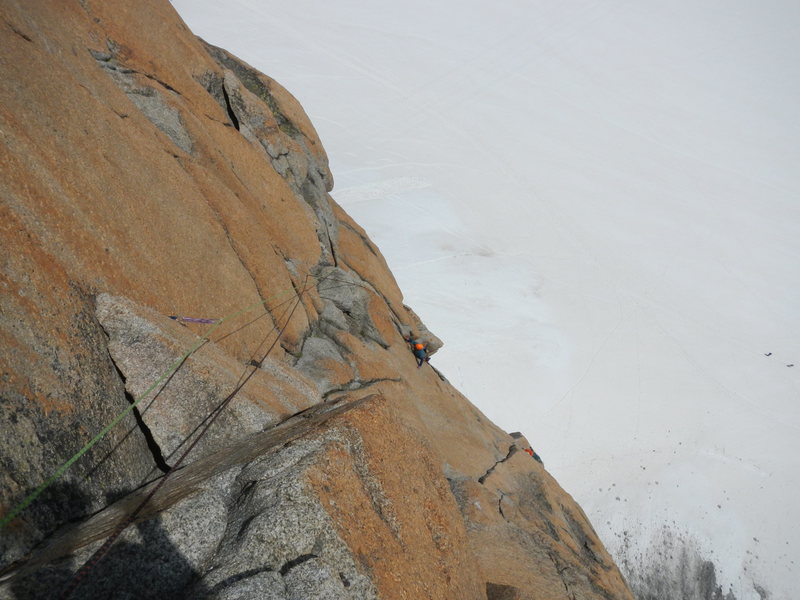Voie Rébuffat-Baquet

5.10- YDS 6a French 18 Ewbanks VI+ UIAA 18 ZA E1 5a British



 Avg: 3.9 from 57
votes
Avg: 3.9 from 57
votes
| Type: | Trad, Alpine, 700 ft (212 m), 11 pitches, Grade II |
| FA: | G. Rébuffat and M. Baquet (1956) |
| Page Views: | 22,342 total · 155/month |
| Shared By: | Seleucus on Jun 18, 2012 · Updates |
| Admins: | Luc-514, David Riley, Bogdan Petre |
Description

The Voie Rébuffat-Baquet is a truly beautiful line in a fantastic setting. The route is rather well equipped for a trad route there are oftentimes pitons in the most difficult sections and most of the belays are equipped for rappel. With the proximity of both the Aiguille de Midi telepherique and the Cosmiques refuge, it has become possible to do this climb with fairly minimal commitment for climbers who would otherwise avoid the long approaches and committing routes of the Chamonix Aiguilles.
That being said, this is a route at high altitude with highly variable weather. Be prepared! Fatigue can quickly slow a party who are unused to climbing at altitude and snow or ice on the route can render otherwise simple pitches very difficult. Furthermore, the weather can change at any moment and rappelling the route in bad conditions can become very difficult.
At the top route-finding can be problematic and there are many different variations. I have included the beta for just one of these variants.
Topo for the Voie Rébuffat-Baquet on Aiguille de Midi
The grades I listed should be taken with a healthy dose of skepticism. Almost every guidebook I own lists a different grade for each pitch of the route and translating these grades from the French scale to the YDS adds an additional element of uncertainty.
Pitch 1 (5.8/5.9): Go straight up and obvious crack/dihedral, pull through a vertical section (5.9), continue on up the dihedral. Next move left along a horizontal crack and go up the face (thin moves) and move under the roof. There are two belays one under the roof and the other at the left edge of the roof. The one on the left makes it easier for the belayer to see the climber on the 2nd pitch.
Pitch 2 (5.10): Typically considered the crux pitch. Move up the s-shapped crack and curve left to a belay.
Pitch 3 (5.10): Move up and to the right following the obvious weakness. Make a tenuous move left and climb up a system comprised of a crack (on the left) and a flake (on the right) until you reach the belay at the top of a column.
Climbers on Pitch 3 & 4 of the Voie Rébuffat-Baquet (photo taken at top of pitch 4 having linked pitches 3 & 4).
Pitch 4 (5.8): Move down and to the left. From here move up to a protruding flake. Move behind the flake or go outside of it to gain a left slanting ramp. Climb the crack on the ramp to an excellent belay ledge (great for a picnic!).
Climbing the crack above the crux on pitch 4 (5.8).
Pitch 5 (5.9): From the belay ledge go right and continue up the ramp. Make awkward moves across a slab and go up the crack system. Belay at the top.
Pitch 6 (5.8): Move up a wide crack (5.8). Here the route splits, going straight up is 5.10, moving to the right and arcing back following good holds and cracks is much easier 5.4/5.5 (as shown on the topo).
The easy variant (5.5) of the 6th pitch.
Pitch 7 (5.9): From the belay move horizontally left on large ledges for about 4 meters. From here move up easy holds (5.7) until you reach a dihedral with a crack in it. The crack has some pitons and stuck nuts. Pull through this crack (5.9) and follow an extremely awkward gully (can be wet from snowmelt). When this ends follow cracks to the left and belay at the top.
Pitch 8 (5.2?): An easy linking pitch. Move down and left then go up a few meteres to a belay. This can be linked with pitch nine but beware of rope drag.
Pitch 9 (5.5): Follow easy holds up a gently sloping gully. The belay is on the right of the gully.
Pitch 10 (5.8): Follow the gully until the end (unless it is full of snow in which case you can follow the ridge on the right) then move up a crack system on the left to a belay on a good ledge.
The snow filled gully on the 10th pitch.
Pitch 11 (5.10+ or 5.8 A0): From the belay move left onto the face and make thin moves (well protected by bolts) until you reach easier climbing on the arête before moving completely onto the right side of the arête. Continue with easy moves to the summit.
Topo for the Voie Rébuffat-Baquet on Aiguille de Midi
Aiguille du Midi, Rebuffat-Baquet, french grades
- More information: chamgranit-topos.com/cham_n…
- Translation from french by Aanoud Petermann

 Continue with onX Maps
Continue with onX Maps Continue with Facebook
Continue with Facebook







































8 Comments